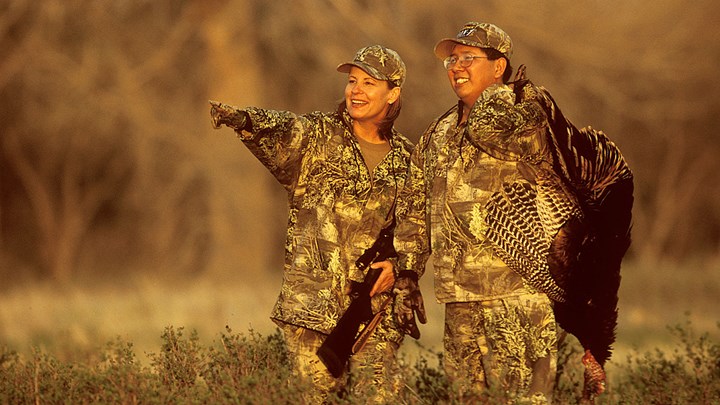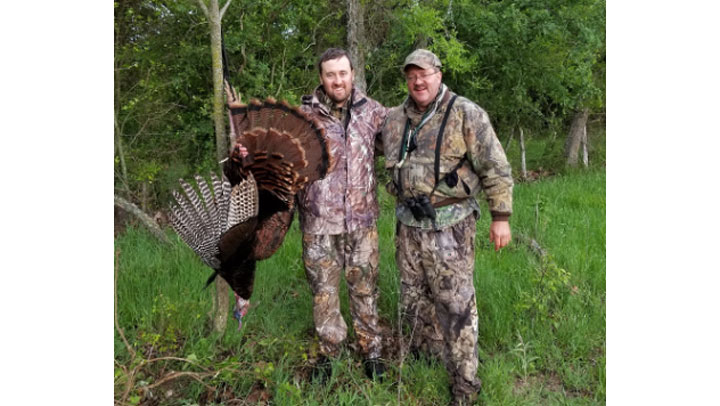
by Chris Lalik - Tuesday, February 6, 2024

“Deep in the guts of most men [and women] is buried the involuntary response to the hunter’s horn, a prickle of the nape hairs, an acceleration of the pulse, an atavistic memory of his fathers, who killed first with stone, and then with club, and then with spear, and then with bow, and then with gun, and finally with formulae.”—Robert Ruark, Horn of the Hunter
One of the highest callings in the hunting community is to pass along our passion. If we can nurture someone else’s innate ability to hear the “hunter’s horn,” not only will we accomplish that goal, we will have people to hunt with in our golden years. I still remember carrying a kitchen chair into the snowy mountains so my grandfather could hunt deer in Upstate New York long after his prime.
Turkey hunting is one of the best ways to light the fire that inspires new hunters to become immersed in America’s rich hunting traditions. The combination of spring’s beauty, smart birds and the arias of the wild can light that passion. For people who like to be outside, turkey hunting is often the first real respite after being cooped up inside all winter. And as every seasoned hunter knows, there are few things better at awakening spring fever than a gobbler thundering at 100 yards.
Once you have had a few seasons of success at filling your own turkey tags, a great way to give back is to take newbies turkey hunting. You can make new friends and pass on the turkey hunting passion to new hunters. You also may not need to carry a gun—and you get to keep hunting even after your own tag is full.

Over the years, I have had the privilege to guide 33 hunters to their first turkeys. They have ranged in age from 8-year-olds to 88-year-old ladies. I have always considered a turkey killed by a new hunter to be worth two killed by myself. As someone who at one point did not even know anyone who hunted turkeys and who hunted for eight years before killing his first turkey in Upstate New York, I fully appreciate the opportunity to inspire and help others in passing along our hunting heritage.
When engaging newcomers, particularly children, I always take them scouting well before the season begins. Often all this involves is getting the kids up early, driving to a place where I know birds are roosting and listening for gobbles. We might sit on a blanket on the truck hood, sip some hot chocolate and make a few owl calls. If the birds gobble and we see them fly down, we have had a great morning. If the kids are up for it, we might take a short hike and look for turkey sign. Even finding a shed antler can help build excitement. Later in the day, a “coyote howler” call is a fairly easy way for a newbie to get a bird to gobble back without educating the turkey. As soon as the kids are cold or bored, we might head to a local diner for breakfast. I think the key with kids is to quit while they still want a little more.
Once the kids I am mentoring are ready to start hunting and we have worked on their gun safety and shooting fundamentals, I cut out pictures of turkeys from magazines and tape them to a cardboard box or target. My new hunters then practice shooting at the middle of the turkey’s neck with an air rifle as we work on shot placement.
If you plan to hunt from a ground blind, do the best you can to simulate being inside one. I actually set up a blind in the basement or back yard where my kids and the neighbors’ kids practice shooting at paper turkey targets. I also spend time teaching them the difference between “shoot” and “don’t shoot” situations, such as teaching them not to shoot when the turkey is in full strut. This is how they learn to wait for the right shot opportunity before pulling the trigger.
I generally make sure new turkey hunters start off using my gun as I know it shoots where the red dot says it will and that my turkey loads pattern well and are lethal. The barrel is also short, making the gun easy to maneuver in a blind. No rookie has ever missed a turkey when using my gun.
I am a big fan of reflex or red dot sights on turkey guns, particularly for new turkey hunters. With the excitement of a tom turkey slowly coming into range, it is very easy for the shooter to lift his or her head in excitement and shoot over the top of the bird when not using that type of sight.
I also spend time teaching new hunters about the common calls turkeys make. It is rewarding to see the excitement they experience as I demonstrate how to work the calls then teach them to mimic the same common turkey sounds—yelps, clucks and gobbles—themselves.
When the big day comes, my new hunter and I will try to roost the birds the night before, waiting until at least an hour after sunset when they are asleep on their roost. We quietly set up the blind about 100 yards from the birds. While you may hear them moving around on the roost due to the disturbance, they will settle down again. I like using a blind because, as long as you can keep the rookie from kicking the blind or talking loudly, you can get away with extra movement. Sometimes this can be a challenge, particularly when birds are coming in and you have children in the blind. Sitting in a blind chair is typically more comfortable than sitting against a tree with roots underneath your cushion.
After setting up the blind the night before, I sometimes crack a Cyalume light stick or tube and hang it from the top of the blind. When kids can see the light as they approach the blind early the next morning, it seems to make it easier for them to stay quiet and focused.
If sitting in chairs in the blind, I prefer a right-handed shooter to be on my left so that I can see everything that is happening with the action of the shotgun. I will also set up a hen turkey before getting in the blind so that it is perpendicular to me with the tail to the left so the Tom will approach from the left side and be in front of the shooter. If possible, I also will have a rest available in the blind to help hold up the gun, which helps the hunter aim and minimize movement.
Most of the adults I have taken out for their first turkeys were people like me who did not have much success the first few years, though they saw birds. Often a conversation would start with the other hunter sharing how he or she really liked to hunt turkeys but how it was tough to close the distance and that they were tough to kill. “Do you have any suggestions?” they would ask. While the hunter’s fire had been lit, some success was needed to keep it burning.
If you have tagged out and still have multiple birds on the property where you hunt, inviting them to hunt with you can be a great option. Or, if you go with them to help them hunt their birds, you probably will make a new friend and may even eventually have a new place to hunt turkeys.
One of my favorite parts of taking new hunters turkey hunting is listening to the cell phone conversations on the way home. I have almost never seen the excitement expressed that compares to when a young girl or boy tells Mom or Dad about his or her very first turkey. In many ways, that is often the first “real” hunting story these young hunters tell—and it is a great privilege to be part of their first hunting story. I once even had a 9-year-old girl ask her friend’s dad (who is also a big hunter) at the end of her first hunting story the following question: “Mr. Sowell, do you know what this means?” After waiting for a response, she impatiently blurted out, “This means I am a real hunter.”
Once again, a new hunter’s fire has been ignited, thanks to spring turkey season, and who knows what adventures are in store.
About the Author
Hunter and NRA contributor Chris Lalik has enjoyed a decades-long career in the hunting and outdoor industry. Today he serves as Sporting Goods Distribution and OEM (Original Equipment Manufacturer) Division Manager at the Sellmark Corporation based in Mansfield, Texas. He dedicates as much time as possible to teaching newcomers about hunting and wildlife conservation, starting with his daughter Katie, who now joins him on many of his adventures.
E-mail your comments/questions about this site to:
[email protected]
Proudly supported by The NRA Foundation and Friends of NRA fundraising.
